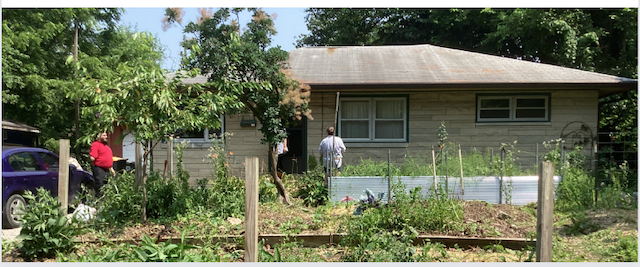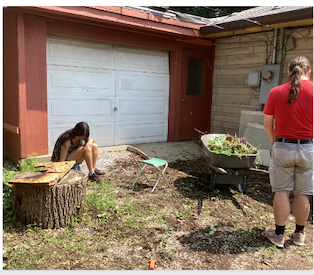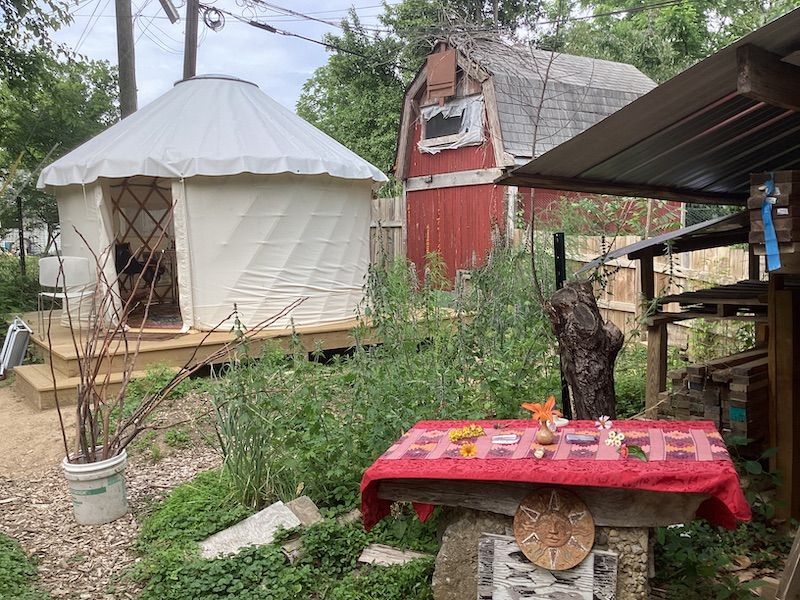A Village Starts Where You Are

THE PROBLEM: Suburban neighborhoods in America have become stereotyped as lonely, sterile places of perfect lawns and people who only meet on the NextDoor app. The chemicals in lawn care have also contributed to pollution of local groundwater, and the streets are all about cars.
WHO'S ALREADY ON IT: In more than one American city, suburban neighbors who put their visions and properties together have created micro-communities, gardening and sharing work to bring down living expenses, restore healthy soil, and create a place to grow relationships as well as vegetables.
Green Acres Permaculture Village began as an agreement between two senior women, living side by side in a 1950s neighborhood of sturdy limestone ranch houses and mature trees in Bloomington, IN. This neighborhood, Green Acres, was built adjacent to Indiana University as a place for families working as IU staff or faculty. Being between the campus and the growing shopping district nearby made Green Acres a comfortable place to raise kids from the 1950s - 1970s. But later decades saw families move away and the houses sold to be student rentals - transient tenants who ignored their yards and their neighbors.
Both of the senior women neighbors wanted something different. Ann Krielkamp had already turned the sunny side of her yard into the Green Acres Neighborhood Garden, where young people from other parts of the city (and a few neighbors) worked together to raise veggies for sharing and sale. She and her neighbor both knew the location was ideal for young people to interact with older adults, if they all had a reason for getting together.
They did their research, talked to their accountants, and in 2009 they made a deal: they would combine their adjacent properties, turn both front and back yards into gardens and workspaces, and open up their homes to be shared with young people and other adults - who had to be committed to living in community and learning permaculture gardening.

Green Acres Permaculture Village is a small, retrofit, intergenerational intentional community in Bloomington, Indiana that integrates self-knowledge and expression with a shared culture among humans and the living Earth to encourage abundance on every level.
-- GAPV Mission Statement
"The evolving Village, currently featuring three adjacent homes with three residents each sharing permacultured grounds, with pathways and commons areas (two greenhouses, a workshop space, chicken house, shed, patio, gazebo, and brand new: a ten foot diameter yurt for visitors), offers itself as a tiny template for the transformation of suburban life in America," the web page reads.
In 2017 and 2022, two other immediate neighbors invited the GAPV to take over their yards for expanded gardens. A third house was purchased and added to the official property of GAPV. Currently, Green Acres Permaculture Village is networked with the Green Acres Neighborhood Association, Dandelion Village (the websites for the first two are somewhat dated), Bloomington Co-operative Living, Bloomington Council of Neighborhood Associations, Lost in the Woods Farm (Gosport, Indiana), NuMundo, and the Federation of Intentional Communities.
#Ground #gardening #education #Civica #communities #regenerative
